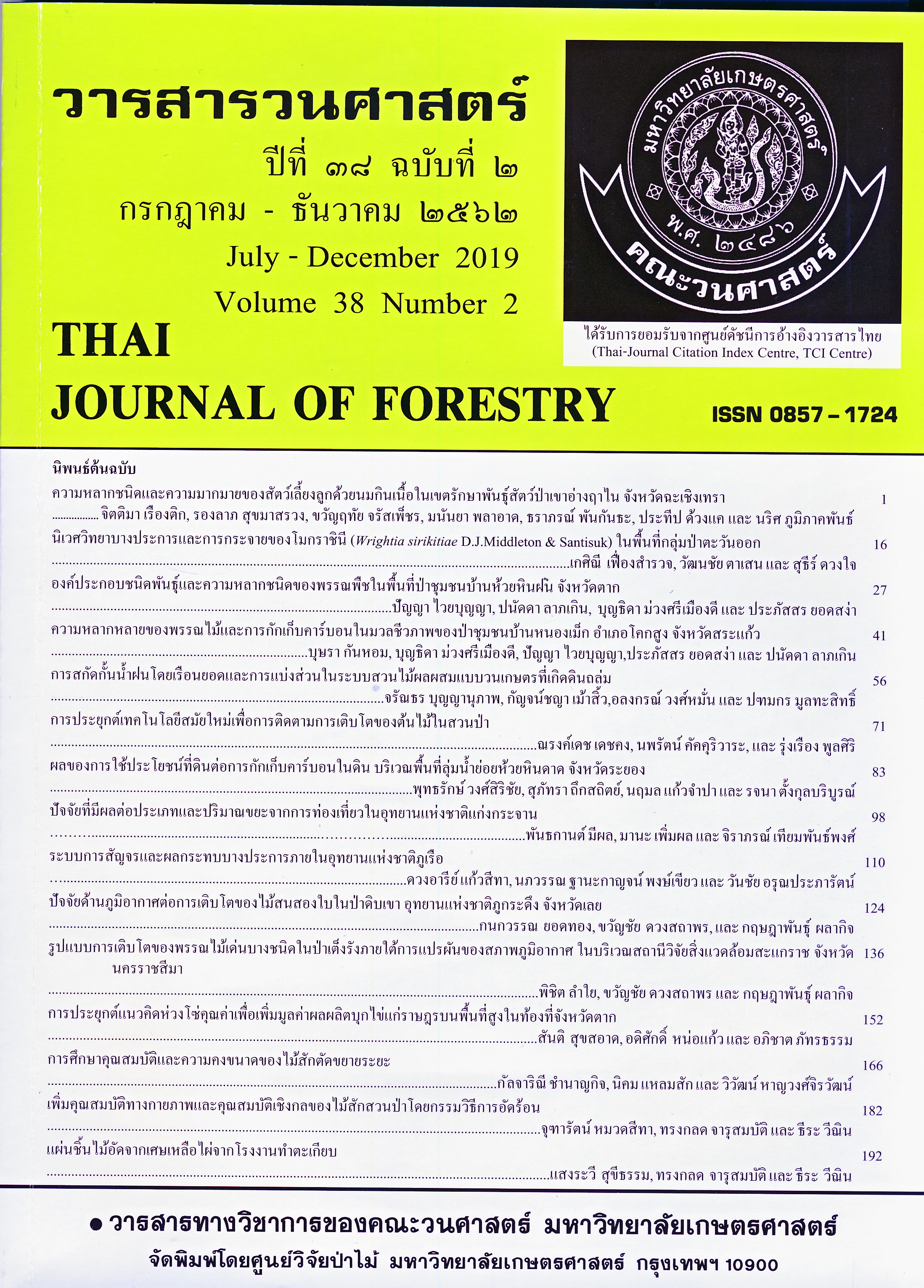แผ่นชิ้นไม้อัดจากเศษเหลือไผ่จากโรงงานทำตะเกียบ
Main Article Content
บทคัดย่อ
การศึกษาการผลิตแผ่นชิ้นไผ่อัดจากเศษไผ่จากการทำไม้ตะเกียบ มีวัตถุประสงค์เพื่อศึกษากรรมวิธีการผลิตแผ่นชิ้นไผ่อัด และเปรียบเทียบคุณสมบัติทางกายภาพและสมบัติเชิงกลตามมาตรฐาน มอก. 876-2547 (TIS, 2004) ซึ่งศึกษาชนิดและปริมาณของกาวที่เหมาะสมต่อการผลิตไม้อัดจากเศษไผ่มีการวางแผนการทดลองแบบสุ่มสมบูรณ์ (completely randomized design) โดยเปรียบเทียบกาว 2 ชนิด คือ กาวไอโซไซยาเนต ชนิด polymeric diphenylmethane diisocyanate (pMDI) ปริมาณร้อยละ 3, 5 และ 7 และกาวยูเรียฟอร์มัลดีไฮด์ (UF) ปริมาณร้อยละ 8, 10 และ 12 ของน้ำหนักไม้แห้งตามลำดับ เป็นตัวประสาน ทำการทดลองจำนวน 5 ซ้ำ ทำการวิเคราะห์ข้อมูลค่าความแตกต่างทางสถิติโดยใช้ Analysis of Variance (ANOVA) และวิเคราะห์ความแตกต่างของค่าเฉลี่ย โดยใช้ Duncan’s New Multiple Range Test
จากการเปรียบเทียบกับค่าตามมาตรฐาน (TIS 876-2004) พบว่า แผ่นชิ้นไผ่อัดที่ผ่านมาตรฐานที่กำหนดทุกค่า คือ แผ่นชิ้นไผ่อัดที่อัดด้วยกาวไอโซไซยาเนต ชนิด pMDI ในปริมาณร้อยละ 7 และแผ่นชิ้นไผ่อัดที่อัดด้วยกาวยูเรียฟอร์มัลดีไฮด์ในปริมาณร้อยละ 12 ผลการศึกษาพบว่า กาวไอโซไซยาเนต ชนิด pMDI ปริมาณร้อยละ 7 ให้คุณสมบัติทางกายภาพและเชิงกลที่ดีที่สุด ซึ่งมีค่าคุณสมบัติทางกายภาพ ได้แก่ ค่าความหนาแน่น ค่าความชื้น และค่าการพองตัวตามความหนา ให้ค่าเฉลี่ยเท่ากับ 659.53 กก./ลบ.ม. , ร้อยละ 9.62 และ ร้อยละ 3.55 ตามลำดับ ส่วนค่าคุณสมบัติเชิงกล ได้แก่ ค่าความต้านแรงดัด ค่ามอดุลัสยืดหยุ่น และค่าความต้านแรงดึงตั้งฉากกับผิวหน้าซึ่งมีค่าสูงสุดเท่ากับ 15.98, 2,661.97 และ 1.12 เมกะปาสกาล (MPa) ตามลำดับ
Downloads
Article Details
ข้าพเจ้าและผู้เขียนร่วม (ถ้ามี) ขอรับรองว่า ต้นฉบับที่เสนอมานี้ยังไม่เคยได้รับการตีพิมพ์และไม่ได้อยู่ในระหว่างกระบวนการพิจารณาตีพิมพ์ลงในวารสารหรือสิ่งตีพิมพ์อื่นใด ข้าพเจ้าและผู้เขียนร่วม (ถ้ามี) ยอมรับหลักเกณฑ์และเงื่อนไขการพิจารณาต้นฉบับ ทั้งยินยอมให้กองบรรณาธิการมีสิทธิ์พิจารณาและตรวจแก้ต้นฉบับได้ตามที่เห็นสมควร พร้อมนี้ขอมอบลิขสิทธิ์ผลงานที่ได้รับการตีพิมพ์ให้แก่วารสารวนศาสตร์ คณะวนศาสตร์ มหาวิทยาลัยเกษตรศาสตร์ กรณีมีการฟ้องร้องเรื่องการละเมิดลิขสิทธิ์เกี่ยวกับภาพ กราฟ ข้อความส่วนใดส่วนหนึ่ง หรือ ข้อคิดเห็นที่ปรากฏในผลงาน ให้เป็นความรับผิดชอบของข้าพเจ้าและผู้เขียนร่วม (ถ้ามี) แต่เพียงฝ่ายเดียว และหากข้าพเจ้าและผู้เขียนร่วม (ถ้ามี) ประสงค์ถอนบทความในระหว่างกระบวนการพิจารณาของทางวารสาร ข้าพเจ้าและผู้เขียนร่วม (ถ้ามี) ยินดีรับผิดชอบค่าใช้จ่ายทั้งหมดที่เกิดขึ้นในกระบวนการพิจารณาบทความนั้น”
เอกสารอ้างอิง
Ashori, A. and A. Nourbakhsh. 2008. Effect of press cycle time and resin content on physical and mechanical properties of particleboard panels made from the underutilized low-quality raw materials. Industrial Crops and Products 28: 225-230.
Bauchongkol, P., V. Fueangvivat, S. Chaichoom, C. Pangwong and P. Hangan. 2012. Potential of wood from thinning of teak-plantation on particleboard manufacture, pp.87-89. In 2012 Annual Research Report. Royal Forest Department, Bangkok.
Howpinjai, I. 2009. Particleboard from Agarwood (Aquilaria spp.) Residues. M.S. Thesis, Kasetsart University.
Kuentham, A. 1996. Experimental Design. Department of Statistics, Faculty of Science, Kasetsart University, Bangkok.
Thai Industrial Standards Institute (TIS). 2004. Flat pressed (FP) Paticleboards. Thai Industrial Standards TIS 876-2004.
Thongkanluang, T. 2004. Study of Physical Property and Thermal Property of Particle Boards Made Form, Clusters of Oil Palm. M.S. Thesis, Surat Thani Rejabhat University.
Yenjai, P. 2015. Particleboard Manufacturing from Waste of Cajuput (Melaleuca cajuputi Powell). M.S. Thesis, Kasetsart University.


